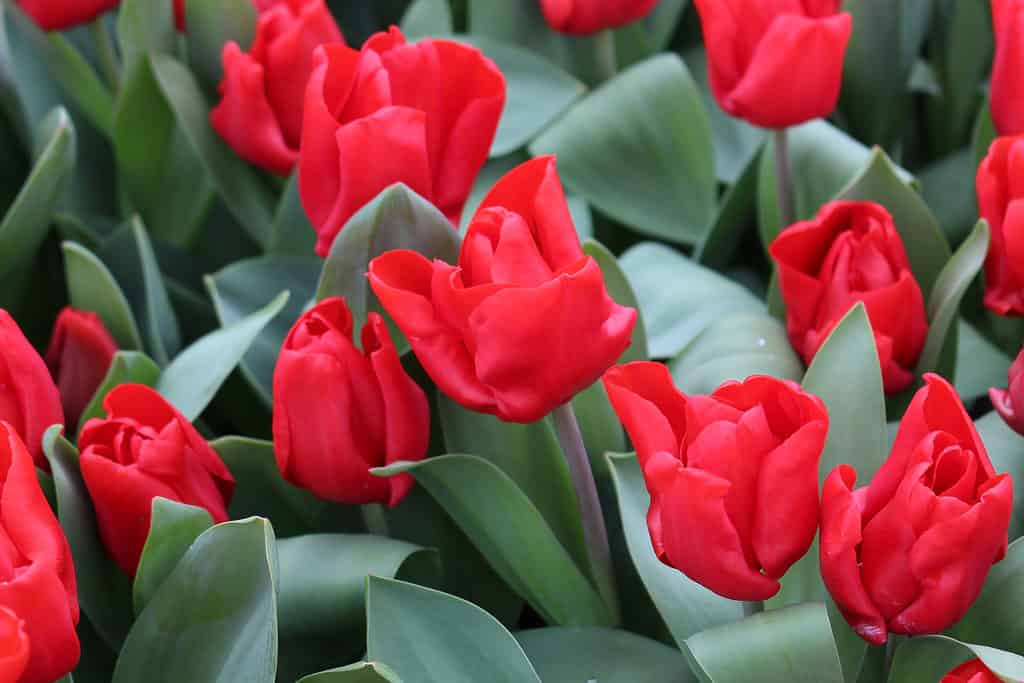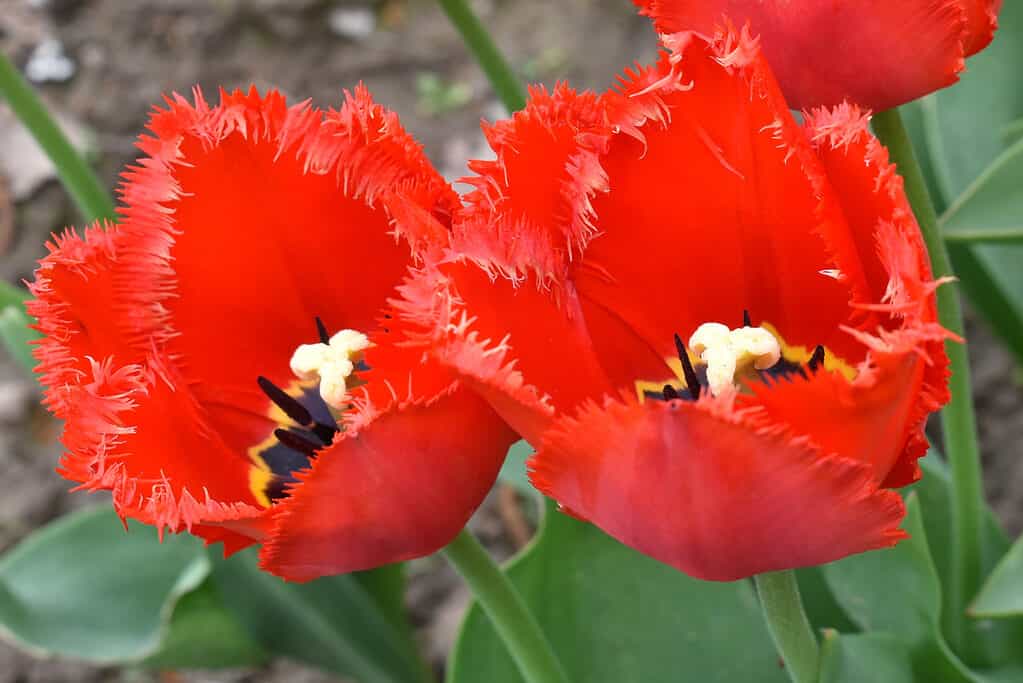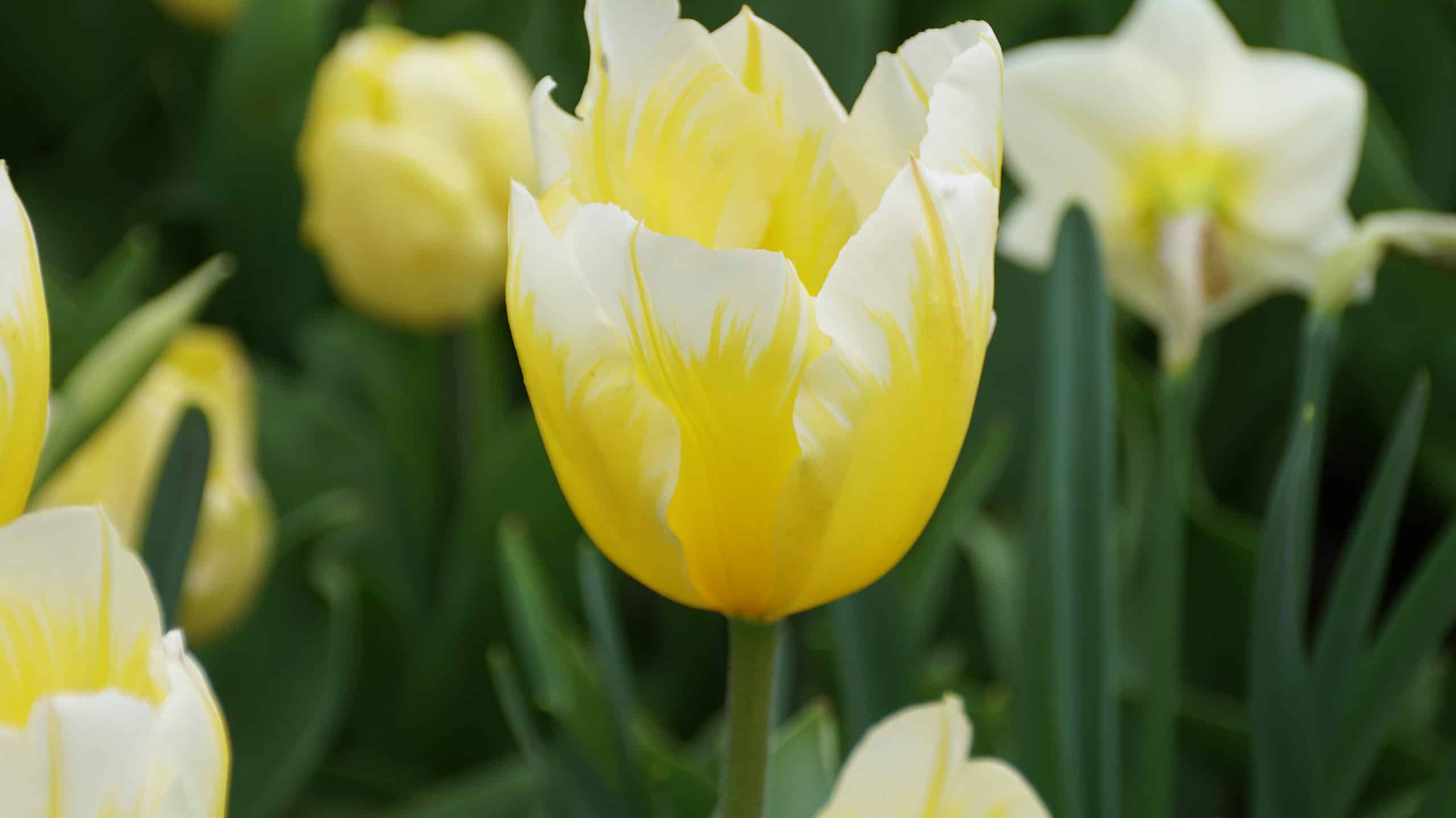What Are Tulips?
A tulip is a type of flowering plant that belongs to the lily family. It is native to Central Asia and has become one of the most popular flowers in Europe and North America. Tulips have large, cup-shaped blooms that come in many different colors, from classic reds, whites, and yellows to more exotic shades of purple and pink.
The size of these flowers ranges from four inches up to six inches. The cultivar “Giant Sunrise” has blooms that are 10 inches wide! Tulips are also known for their signature pointed petals which often curl back at the tips when they are fully open. They make excellent cut flowers as they can last up to two weeks indoors with proper care!
When Are Tulips in Season?
Tulips are typically in season during the spring months, usually mid-March through May. The exact time frame for tulip season varies depending on your location and climate. In northern regions, such as Canada and the northern United States, tulips may bloom a bit earlier than in milder climates. Tulips can be found at flower shops or garden centers throughout their peak blooming period. If you want fresh-cut tulips from a field, you’ll need to check with local growers when they expect their crops to be ready for picking.

Tulips have large, cup-shaped blooms that come in many different colors. They are in season from mid-March through May.
©Andrianova Tanya/Shutterstock.com
How to Force Tulips to Bloom Out of Season
Forcing tulips to bloom out of season is a great way to enjoy the beauty of these flowers all year round. The process is relatively simple and requires only a few steps.
First, you need to find a cold place where temperatures remain below 40 degrees Fahrenheit for ten weeks or longer. To achieve this, you can use an outdoor shed or garage in winter months or even a refrigerator.
Once your tulip bulbs have been exposed to these conditions for long enough, take them out and move them into an area that’s above 55 degrees Fahrenheit — such as inside your home near a window with plenty of sunlight — in order for them to start growing and blooming again. Be sure not to overcrowd the space when transplanting them. They need to have plenty of air circulation. Otherwise, their growth could be stunted by too much humidity. With proper care and attention during the forcing process, you should see beautiful results within several weeks!
How to Make Tulips Last Longer
When you want your tulips to last longer, there are several steps you can take. First, make sure that when you buy fresh tulips from the store or market, they’re still in their closed-bud form. This will help them keep their color and vibrancy for a more extended period of time.
When arranging the flowers in a vase at home, cut off about an inch of the stem and place them in warm water with flower food added to it. The warmer temperature helps speed up the opening process, so the flowers have more time to be enjoyed before wilting away. Additionally, avoid placing them near direct sunlight or heat sources, such as radiators or fireplaces, which can cause them to wither quickly.
Finally, try changing out the water every few days. Remember to trim any discolored petals so they don’t spread throughout your arrangement. This also provides an opportunity for fresh stems to drink up all that lovely nutrient-rich liquid. If you follow these steps, your tulips will last an extra week in a vase!
Where to See Tulips in Season?
Tulip festivals are a popular way to admire the beauty of these exquisite flowers. Every year, many countries around the world celebrate their local tulips with an array of events and activities. For example, Holland holds two large-scale celebrations during the peak blooming season: The Keukenhof Tulip Festival and The Floralia Amsterdam Tulip Festival. At both festivals, you can expect colorful fields of tulips in vibrant shades ranging from purple to pink to red.
Tulip festivals feature music performances, food stalls serving traditional treats like pancakes and stroopwafels, art exhibitions showcasing unique tulip creations by local artists, and interactive activities such as flower arranging workshops and photo contests featuring photography inspired by tulips. All of this is to celebrate the beauty of these iconic springtime blossoms! So whether you’re looking for a day out or simply want to bask in nature’s splendor while sipping on some hot cocoa, don’t miss out on your chance to experience a flower festival!
In the United States, several tulip festivals take place throughout the spring. The biggest and most popular of these is the Skagit Valley Tulip Festival in Washington State. This festival takes place each April and features millions of blooming tulips spread across over a hundred acres of flower fields. Other places to see large displays of tulips include Holland, Michigan’s Windmill Island Gardens, Oregon’s Wooden Shoe Tulip Farm, and Virginia’s Great Meadow International Flower Festival. In addition to these organized events, some cities like Philadelphia also have smaller public tulip gardens where visitors can see beautiful displays up close.
6 Types of Tulips
Tulips come in a variety of colors, from soft pastels to bold hues, and can feature bicolor or multicolor petals. Single-flower tulips have the classic cup shape with three petals and three sepals that appear as six distinct petals due to their similar size and shape. There are 15 different classifications of tulips, but only six of them are grown as cut flowers. Here they are below.
Single Early Tulips
Single early tulips, also known as single-flowered tulips, are a species of bulbous perennial plants in the genus Tulipa. They usually bloom in early spring and are one of the earliest flowering types of tulips. Some popular cultivars include “Apricot Beauty,” “Allure” and “Red Riding Hood.” Single Early Tulips tend to have long stems and cup-shaped blooms with short petals that can range in color from white to yellow to red. The flowers typically measure 1.5 – 3 inches wide. They can last up to two weeks when cut for bouquets or floral arrangements.

Single early tulips, also known as single-flowered tulips, include the “Red Riding Hood” cultivar.
©Tatiana Alex/Shutterstock.com
Double Early Tulips
Double-flowered tulips, also known as Double Early Tulips, are a popular type of tulip. They have multiple layers of petals per flower and can reach heights up to 16 inches tall. This type of tulip is usually one of the earliest blooming varieties in the spring season. Typically, flowers bloom from late March to early April in most climates. Popular cultivars include “Menton,” “Shirley,” and “Daydream.” These cultivars boast beautiful colors, such as deep purple or yellow, that contrast with their white edges. The double-flowering variety is more prone to disease than others but still makes an excellent choice for gardeners who want a reliable bloomer throughout the spring season.

Double-flowered tulips, also known as double early tulips, include the “Menton” cultivar.
©Nanzyprom/Shutterstock.com
Double Late Tulips
Peony flowered tulips, also known as double late tulips, are a type of showy garden tulip with large double blooms. They usually bloom in late April or early May and come in various colors, including pink, yellow, white, and red. Some popular cultivars include the “Angelique,” which is deep pink; the “Tequila Sunrise,” which has yellow petals streaked with orange-red hues; and the “Bouquet Parfait” with its bright red petals fading to creamy white edges. Peony-flowered tulips make an excellent addition to any garden due to their long-lasting blooms and attractive appearance.

Peony flowered tulips, also known as double late tulips, include the “Blue Spectacle” cultivar.
©LesiChkalll27/Shutterstock.com
Lily-Flowered Tulips
Lily flowered tulips are a type of tulip that features reflexed pointed petals. These petals have an outward curving shape, similar to the petals of lilies. This type of tulip is known for its bright colors and bold appearance in flower beds or pots. They usually bloom around March and April in most parts of the world. However, they can also be found as early as February, depending on your location. Some popular cultivars include “Angelique,” “China Town,” “Purple Prince,” and “Red Impression.” All these varieties feature colorful blooms with deep green foliage to add contrast to any garden setting.

Lily flowered tulips are a type of tulip that features reflexed pointed petals.
©Sergey V Kalyakin/Shutterstock.com
Parrot Tulips
The Parrot tulip is a unique type of tulip characterized by its “feathered” petal edges. This gives the appearance that each petal is made out of feathers or ruffles. The Parrot tulip typically blooms in early to mid-spring and can be found in many different colors, including white, yellow, pink, purple, red, and orange. Some popular cultivars include the “Queen of Night,” the “Flaming Parrot,” and the “White Marvel.” These varieties all have distinct looks that make them stand out among other types of tulips.

The Parrot tulip is a unique type of tulip characterized by its “feathered” petal edges.
©iStock.com/Laurent Gravier
Fringed Tulips
Fringed tulips are characterized by petals that have frilled or jagged edges. These tulips can be either single-flowered or double-flowered varieties. Fringed tulips usually bloom in the late spring, starting in early April and lasting through May. Some popular cultivars of fringed tulips include “Tulipa Flaming Flag,” “Tulipa Clusiana Var Chiarini,” and “Tulipa Fosteriana.” These cultivars come in a variety of colors, including white, yellow, pink, red, purple, and orange. The frilly petal edges give them an extra bit of charm as well.

Fringed tulips are characterized by petals that have frilled or jagged edges.
©Ritvars/Shutterstock.com
Thank you for reading! Have some feedback for us? Contact the AZ Animals editorial team.








